

 |
Search the Site with

|
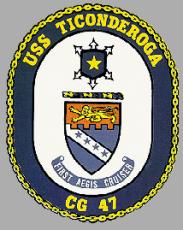 | 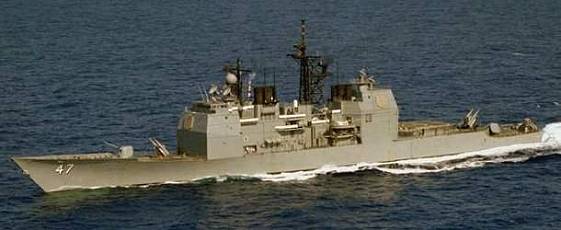 |
USS TICONDEROGA was the lead ship of the TICONDEROGA - class of guided missile cruisers and the fifth ship in the Navy to bear the name. She was the world's first warship equipped with the AEGIS combat system. USS TICONDEROGA was decommissioned on September 30, 2004, and was subsequently laid up at the Naval Inactive Ships Maintenance Facility, Philadelphia, Penn. In September 2020, she was towed to Brownsville, Tx., for scrapping.
| General Characteristics: | Keel Laid: Jan. 27, 1980 |
| Launched: April 25, 1981 | |
| Commissioned: January 22, 1983 | |
| Decommissioned: September 30, 2004 | |
| Builder: Ingalls Shipbuilding, West Bank, Pascagoula, Miss. | |
| Propulsion system: four General Electric LM 2500 gas turbine engines | |
| Propellers: two | |
| Blades on each Propeller: five | |
| Length: 567 feet (173 meters) | |
| Beam: 55 feet (16.8 meters) | |
| Draft: 34 feet (10.2 meters) | |
| Displacement: approx. 9,600 tons full load | |
| Speed: 30+ knots | |
| Cost: about $1 billion | |
| Aircraft: two | |
| Armament: two | |
| Crew: 33 Officers, 27 Chief Petty Officers and approx. 324 Enlisted |
Crew List:
This section contains the names of sailors who served aboard USS TICONDEROGA. It is no official listing but contains the names of sailors who submitted their information.
USS TICONDEROGA Cruise Books and Pamphlets:
About the Ship's Coat of Arms:
 The Shield:
The Shield:
The history of the name Ticonderoga and the four ships that have borne that name is represented by the symbols on the shield. The name Ticonderoga is from the Iroquois Indian word meaning "between two waters" and is symbolized by the white band separating the blue lower half of the shield. The four dark blue stars symbolize the previous four ships bearing the name TICONDEROGA. The historical capture of Fort Ticonderoga is commemorated by the embattled partition line with the gold lion on the red field above it signifying the British adversary during the Revolutionary War. The motto "FIRST AEGIS CRUISER" emphasizes the significance of the new combat system and the ship which carries it.
The Crest:
The AEGIS Weapon System, a surface ship combat systems which has as its motto "Shield of the Fleet", is symbolized by the blue shield of a shape distinctive to the AEGIS System. The single gold star represents CG 47, the fifth ship to bear the name TICONDEROGA and the first combatant to carry the shield to sea. The spears extending from the shield reflect TICONDEROGA's mighty offensive armament capabilities and unparalleled firepower which permit her to operate in a multi-threat environment and take on any air, surface and subsurface target which the Battle Group might encounter.
Accidents aboard USS TICONDEROGA:
| Date | Where | Events |
|---|---|---|
| September 10, 1984 | Atlantic | Fire in the exhaust vent of USS TICONDEROGA injures 13 crew members and forces the ship to return to its homeport of Norfolk, Va., for repairs. The cause of the fire is unknown. |
About the Name "TICONDEROGA":
When the Department of Navy announced in February 1980 that the lead ship of a new class of
The newest ship was named, not after the great stone fortress itself, but in commemoration of the capture of Fort Ticonderoga on 10 May 1775 by Ethan Allen and the Green Mountain Boys. The first ship named TICONDEROGA (1814 - 1825) was a 17-gun schooner of Commodore MacDonough's Flotilla in the victorious Battle of Lake Champlain on 11 September 1814. The second TICONDEROGA (1863 - 1881) was a steam sloop-of-war which served with distinction during the Civil War. A former German cargo ship was transformed into the third TICONDEROGA (1917 - 1918), which served the Naval Overseas Transportation Service during World War I. The fourth ship was the famed aircraft carrier TICONDEROGA (CV 14), affectionately known as "The Big T," which served from 1944 to 1973, earning 17 Battle Stars for service during World War II and the Vietnam War. The carrier also received three awards of the Navy Unit Commendation and the Meritorious Unit Commendation for service during the Vietnam War.
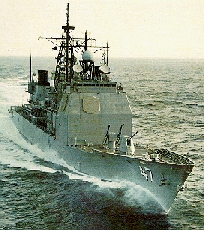
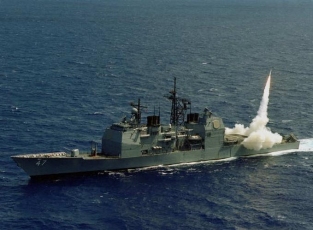
USS TICONDEROGA's Commanding Officers:
| Period | Name |
|---|---|
| January 22, 1983 - February 1985 | Captain R. G. Guilbault, USN |
| February 1985 - March 1987 | Captain R. M. Walsh, USN |
| March 1987 - August 1989 | Captain J. M. Arrison III, USN |
| August 1989 - June 1991 | Captain M. C. Foote, USN |
| June 1991 - June 1993 | Captain E. F. Messina, USN |
| June 1993 - June 1995 | Captain G. A. Storm, USN |
| June 1995 - December 1996 | Commander C. T. Bush, USN |
| December 1996 - June 1998 | Commander D. G. Yoshihara, USN |
| June 1998 - June 2000 | Commander K. H. Dietrich, USN |
| June 2000 - January 2002 | Commander G. R. Sears II, USN |
| January 2002 - September 30, 2004 | Commander G. W. Zeiders III, USN |
History of USS TICONDEROGA:
Authorized in Fiscal Year 1978, TICONDEROGA's keel laying ceremony occurred on 27 January 1980. Over the next three years, Combat Systems Engineers and Computer Technicians, as well as riveters, welders and Propulsion Engineers worked together as members of a unique team to create this formidable warship.
On 25 April 1981, TICONDEROGA was launched, and for the first time was afloat in her natural environment. The following month, on 16 May 1981, the then First Lady, Mrs. Nancy Reagan, the ship's sponsor, accompanied by military and civilian dignitaries, christened TICONDEROGA, with some 9,000 people in attendance.
TICONDEROGA was built in sections, called modules, which allowed improved access to all areas of the ship during construction. The modules were then moved together to form the hull of the ship, and the deckhouse sections were then lifted aboard. For launching, the ship was moved several hundred yards across land to the floating dry dock, which was used to actually launch the ship.
An extensive test and check-out effort and outfitting period was then undertaken as the mighty hull was brought to life. TICONDEROGA men arrived in Pascagoula in July 1981 and crew training, certification and systems check-out were underway. Sea trials were held in May, August, and November of 1982. During the first trial, TICONDEROGA's propulsion systems were stringently tested, passing with flying colors. The new cruiser accomplished a four-hour run at full power, achieving a speed in excess of 30 knots.
On its second trial, TICONDEROGA and her Navy crew accomplished an unprecedented "Navy First." She flexed her muscles for the first time, 6 months prior to commissioning, by successfully firing every weapon system on board. This included two Anti-Surface Harpoon Blast Test Missiles, 11 Surface-to-Air Blast Test Missiles,
TICONDEROGA was delivered to the Navy on 13 December 1982. Following commissioning, she moved to Norfolk, her home port. During the next year, CG 47 was scheduled to participate in extensive Combat System and Engineering Exercises, as well as intensive single ship and Battle Group readiness evolutions. She returnd to Pascagoula in the Summer for a six-week Post-Shakedown Availability.
In 1984, the TICONDEROGA stood out on her maiden deployment. Operating with the USS NEW JERSEY (BB 62), the TICONDEROGA provided naval gunfire support in the Mediterranean off Lebanon.
TICONDEROGA again deployed to the Mediterranean from February to September 1986. Accompanied by USS CARON (DD 970) and USS SCOTT (DDG 995), TICONDEROGA served as lead ship across the "Line of Death" and acted as the on-scene air-warfare commander during the exercise in the Gulf of Sidra and as well as during the subsequent removal of SAM batteries that launched an SA-5 missile against an F-14 from AMERICA (CV 66). During the deployment, TICONDEROGA also conducted combat SAR operations for one F-111 that was lost during "Line of Death" operations. It was later discovered that the F-111 had been shot down by a Libyan ZSU-23.
A remarkable fact about TICONDEROGA is that she had launched over 100 SM-2's before she was three years old.
USS TICONDEROGA's third cruise started on 10 September 1987 and took her to the Mediterranean, North Atlantic and Indian Ocean. TICONDEROGA operated with the IOWA (BB 61) and DEYO (DD 989) for the whole cruise and with DEWEY (DDG 45), PAUL (FF 1080) and CANISTEO (AO 99) for the Mediterranean and NorLant.
On this deployment, TICONDEROGA also took part in several Operation Earnest Will missions in the Persian Gulf. The TICONDEROGA returned home on 10 March 1988 after a deployment during which she was without carrier support for most of the time. Negative consequence for the crew: no mail.
Assigned to the USS DWIGHT D. EISENHOWER (CVN 69) Battle Group, the TICONDEROGA left the US east coast on 8 March 1990 on her fourth deployment. Following the Iraqi invasion in Kuwait on 2 August 1990, the Battle Group was ordered into the Persian Gulf, arriving there 8 August and participating in Operation Desert Shield - the build-up of coalition forces in the Gulf area. Relieved by the USS JOHN F. KENNEDY (CV 67) Battle Group 24 August 1990, the DWIGHT D. EISENHOWER (CVN 69) Battle Group returned home 12 September 1990.
USS TICONDEROGA took part, in May 1995, in an 11-day exercise, called Destined Glory '95, The exercise took place in the western Mediterranean south of Sardinia and included more than 20 ships and thousands of troops from the NATO countries of Greece, Italy, Netherlands, Spain, Turkey, U.K. and the U.S. This marked the first time, NATO countries conducted a fully integrated amphibious exercise in an air, land and sea training environment. USS TICONDEROGA was in the Mediterranean as part of the THEODORE ROOSEVELT Battle Group, having left its homeport on March 22.
It deployed with the THEODORE ROOSEVELT and other battle group ships to the Arabian Gulf in support of Operation Southern Watch, the enforcement of the no-fly zone over Iraq. It then deployed back to the Adriatic to take station for Operation Deny Flight, the U.N.-mandated no-fly zone over Bosnia. The THEODORE ROOSEVELT reported on station May 26.
In June of 1996, TICONDEROGA shifted homeports from Norfolk, Virginia, to Pascagoula, Mississippi as part of Western Hemisphere Group. TICONDEROGA's focus changed from United States Navy battle group operations to independent steaming and working with South American Navies during counter-narcotics operations.
In April of 1999, TICONDEROGA commenced a SMART SHIP installation designed to replace analog control systems with new digital systems. USS TICONDEROGA was the first production Smart Ship cruiser fielded in the summer of 2000, undergoing the upgrade at Naval Station Pascagoula. After fourteen long months of installations and ship alterations, TICONDEROGA completed sea trials. The crew next prepared for various readiness and operational inspections. Light Off Assessment (LOA) was conducted in late May prior to sea trials and Engineering Department put in numerous off-duty hours preparing the ship’s engineering spaces. Sea trials with the new SMART SHIP program went smoothly on June 1st and 2nd without any major problems.
USS TICONDEROGA took part in the mid-October 2000, Atlantic phase of the 41st annual "Unitas" Task Group deployment. The purpose of "Unitas" is to conduct multi-lateral naval operations including traditional at-sea exercises and inport activities with participating naval forces in support of U.S. foreign policy in South America. During the Atlantic phase, the TICONDEROGA made a stop at the port city of Ushuaia, located in the Patagonia region on the southern tip of Argentina, which it departed from on October 4th. The vessel later visited Rio de Janeiro, Brazil, October 23, 2000, as part of a four U.S. Navy ships contingent.
After a holiday vacation, the crew of America’s First Aegis Cruiser returned to sea in late January to mid-February 2001. TICONDEROGA served as flagship for DESTROYER SQUADRON SIX, its immediate superior in charge, and completed a Group Sail with several other ships in the squadron. Events included tactical maneuvering, seamanship exercises, communications drills, and electronic warfare exercises to prepare for upcoming deployments. Each ship had the opportunity to fire a Standard missile to maintain combat readiness standards. The missile launches were the highlight of the Group Sail.
TICONDEROGA’s crew next prepared for INSURV, a mandated inspection that occurs on board each U.S. Navy ship every five years. The inspection is a material and systems readiness assessment to prove how well a crew has maintained their ship. Many crewmembers have dedicated numerous off-duty hours to ensure all navigation, engineering, electronic, and combat systems equipment are ready for the inspection.
From April to August 2001, TICONDEROGA was to loosen all lines and deploy in support of U.S. Southern Command operations. USS TICONDEROGA participated in Teamwork South, a series of challenging naval exercises in the Southeastern Pacific Ocean with Guided Missile Frigate RODNEY M. DAVIS (FFG 60), twelve Chilean warships and the British Destroyer HMS EDINBURGH (D 97). The exercise was completed in mid-July 2001 and included a live fire Sink Exercise (SINKEX) on the ex-USS LA MOURE COUNTY (LST 1194) unmanned hulk target, which had been decommissioned after an accident off the coast of Chile the previous year and whose use as a target was determined to outweigh the cost of potential repairs.
After September 11, 2001, TICONDEROGA was the first ship out of Pascagoula to participate in OPERATION NOBLE EAGLE as South-East Sector Air Defense Group Commander.
Bender Shipbuilding & Repair Co. Inc., Mobile, AL, was awarded a $7,990,455 firm-fixed-price modification to a previously awarded contract for the drydocking selected restricted availability of USS TICONDEROGA. As of January 2002, work was performed in Mobile, AL, and was completed by June 2002.
From March to August 2004 TICONDEROGA completed her final deployment, one of the most successful counter-narcotics operations on record. Her efforts led directly to narcotics interdictions totaling 14,406 pounds of cocaine, four Go-Fast smuggling vessels, one smuggling fishing vessel, 25 prisoners and 5 Logistic Support Vessels. In addition, TICONDEROGA worked in conjunction with Costa Rican and Colombian Navies to interdict two additional Go-Fast vessels.
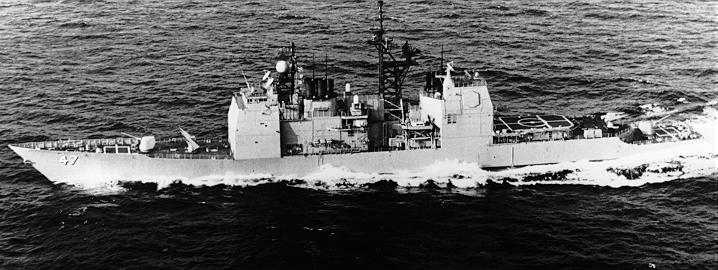
USS TICONDEROGA Patch Gallery:
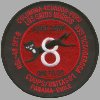 |
USS TICONDEROGA Image Gallery:
 | 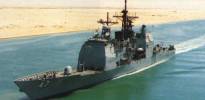 |  |  | |
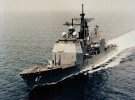 | 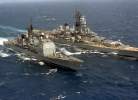 | 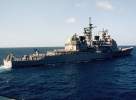 | 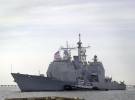 | 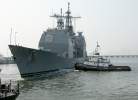 |
The photo below was taken by Karl-Heinz Ahles and shows USS TICONDEROGA at Naval Station Pascagoula, Miss., on May 17, 1999.
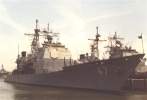 |
The photos below were taken by Brian Barton on October 13, 2008, and show the TICONDEROGA laid up at the Philadelphia Naval Shipyard. The ships next to the TICONDEROGA are CONOLLY (DD 979), THOMAS S. GATES (CG 51) and the ARTHUR W. RADFORD (DD 968).
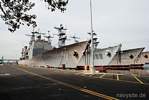 | 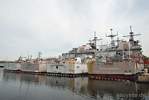 |
The photos below were taken by me on November 7, 2008, and show the TICONDEROGA laid up at the Philadelphia Naval Shipyard.
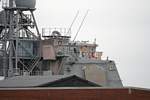 | 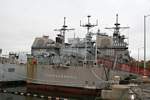 | 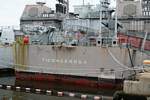 | Click here to view more photos. | |
The photos below were taken by me on October 26, 2010, and show the TICONDEROGA still laid up at the Philadelphia Naval Shipyard.
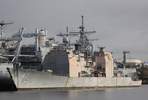 | 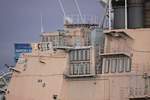 | 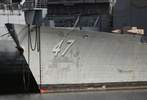 | Click here to view more photos. | |
The photos below were taken by me on May 4, 2012, and show the TICONDEROGA still laid up at the Philadelphia Naval Shipyard.
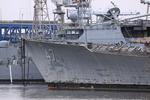 | 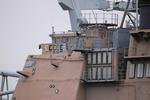 | 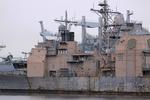 | 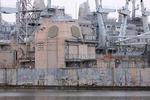 | 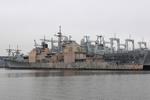 |
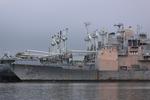 |  | 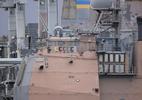 |
The photo below was taken by Michael Jenning on October 3, 2012, and shows the TICONDEROGA laid up at the Philadelphia Naval Shipyard.
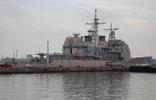 |
The photos below were taken by Michael Jenning on October 7, 2018, and show the TICONDEROGA laid up at the Philadelphia Naval Shipyard.
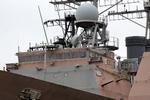 |  |
 Back to Cruisers list.
Back to Cruisers list.  Back to ships list.
Back to ships list.  Back to selection page.
Back to selection page.  Back to 1st page.
Back to 1st page.